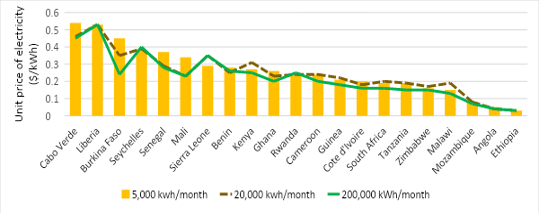Electricity for industrialization and economic growth
Industrialization is a central tenet of nearly every African country’s economic development program (see, for example: Rwanda Vision 2050, Plan for an Emerging Senegal, Kenya Vision 2030, and the Ethiopia Homegrown Economic Reform Plan). But no country on earth has built a diversified, industrialized economy without widespread access to reliable and affordable electricity.
The cost of electricity for commercial customers is extremely high in most African countries (Figure 1). This places an enormous burden on firms that need affordable power in order to increase productivity, create jobs, and compete in a global marketplace, making affordable electricity a primary barrier to economic development on the continent.1
FIGURE 1: Unit price of electricity by standardized consumption

Note: The World Bank estimated the final unit cost of electricity (US$/kWh) for non-residential customers at various monthly consumption levels across sub-Saharan Africa.2 The calculated cost includes factors like the unit charge, tariff structure, fixed charges, variable charges, and taxes, as well as incentives such as demand charges, time-of-use provisions, and block tariffs.
Despite this, many governments and donors still consider expanding access to be the primary goal. In contrast, affordability receives less attention and is often overlooked in global monitoring efforts. For example, the multi-institutional group tracking progress toward Sustainable Development Goal 7 — which aims for “affordable, reliable, sustainable and modern energy for all” — provides cross-country data on access but no analysis on affordability.3 And while the World Bank Multi-Tier Framework (MTF) defines affordability for household consumers as “basic service less than 5% of a household income,” no such guidelines exist to track affordability among non-residential consumers, who use the most electricity across African power markets and drive economic growth and job creation.4
Challenges of framing affordability
Framing and tracking affordability is complicated, because:
- Affordability is relative. Affordability and willingness to pay depend entirely on consumer groups and demographics, and a fixed definition can’t capture nuances, such as:
- Industrial consumers, whose cost of production (and therefore competitiveness) is highly sensitive to the cost of electricity, require lower prices than the services sector, which can tolerate higher tariffs.
- Domestic consumers are more willing to pay a premium rate for energy services that absolutely require electricity (such as phone charging), than for others (such as cooking) that can be met by cheaper alternatives.
- US¢ 15/kWh could be expensive for the residents of Makoko, a low-income area in Lagos, but affordable for those living in the affluent neighborhood of Ikoyi.
- Affordability isn’t just about the tariff rate. Connection costs, quality of service, relevant subsidies, environmental impacts, and taxes all play a role in “affordability”. Understanding and tracking affordability is challenging within a specific national context, and even more so across several countries or regions.
Recommendations
- Develop a universal composite electricity affordability index for non-residential consumers: The lack of a standardized definition of affordability for non-residential consumers means that there is no way to comprehensively track SDG 7. International institutions must develop a composite index that measures affordability using a single value that systematically combines the variations of cost associated with demand (kW) and consumption (kWh) across a representative set of non-residential user classes.
- Incorporate tariff targets for non-residential users in long-term electricity sector planning: Most African countries have electrification strategies, master plans and least cost power development plans that include targets for electrification, generation capacity, renewable energy, and the extent of the distribution network. These plans should also include targets for non-residential consumer tariffs suited to support economic growth.
- Expand the use of demand-side management approaches to lower cost: Time-of-use tariffs can optimize power systems, improve load factors, and reduce the cost of electricity for commercial and industrial consumers — utilities across the region should widely adopt this approach. Kenya, Rwanda, Malawi, Cameroon and several other countries already have a form of time-of-use arrangement.
Endnotes
- Blimpo, M., and Cosgrove-Davies, M. (2019) Electricity Access in Sub-Saharan Africa: Uptake, Reliability, and Complementary Factors for Economic Impact. Africa Development Forum; Washington, DC World Bank. https://openknowledge.worldbank.org/handle/10986/31333
- Kojima, M., and Han, J. (2017) Electricity Tariffs for Non-residential Customers in Sub-Saharan Africa. Live Wire;2017/77. World Bank, Washington, https://openknowledge.worldbank.org/handle/10986/26571
- The custodian agencies are the International Energy Agency (IEA), the International Renewable Energy Agency (IRENA), the United Nations Statistics Division (UNSD), the World Bank, and the World Health Organization (WHO).
- ESMAP (2015) Beyond connections: Energy access redefined, Energy Sector Management Assistance Program, World Bank Group, Washington DC.
